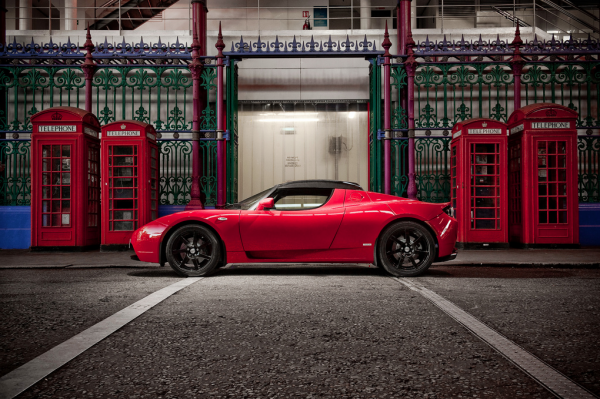When one considers their design, electric cars should be much cheaper. The motor is simpler, there are only a few moving parts, and the battery… well, this is where the electric car has always been limited.

A look back
Many people don’t realize that the electric car didn’t only gain acceptance after gas prices spiked. During the early 1900s, electric cars were very competitive with gas cars in sales, and were particularly favored for their silence in operating, lack of pollution, and increased safety.
In contrast, gasoline cars were noisy, put out plumes of smoke, and required a dangerous manual pull to start. There was also little infrastructure for gas cars. The corner gas station was not the ubiquitous business it is today, and many people found it easier to plug in an electric car than search for a gas pump.
However, advancements in gas-powered cars eliminated the dangerous starting procedure, removing a major selling point of electrics. Additionally, Henry Ford’s Ford Motor Company (NYSE:F) began to build the car for the average Joe, and it was gas-powered.
A wave of Model Ts swarming American roads increased demand for things like, well, American roads. As roads were built, the car became a symbol of freedom. It represented the ability to get out of the city and travel into the country, something the range of early electric cars could not offer. With the automakers that would become the Big Three promoting gas-fueled transportation, the electric car receded from the mainstream, only to resurface during times of high fuel prices or new environmental legislation.
Who killed the electric car? (early 1900s edition)
A post-electric autopsy on this situation reveals that electric cars were largely let down by their batteries. Had electric cars of the early 1900s had the range of a Tesla Motors Inc (NASDAQ:TSLA) Model S, that 265 miles of travel would have easily sufficed for almost anyone’s country jaunt at the time.
Ultimately, the Big Three would produce what they saw as most profitable. Even with the Model T running on gasoline, rival automakers would likely have seen potential in an electric car with a 265-mile range. Consequently, electric cars would have been produced, and the splitting of sales between electrics and gas cars could have continued.
Battery challenges continue
When most people think “electric car” today, they think something like the Chevrolet Volt, produced by General Motors Company (NYSE: GM) or the Nissan Leaf. While it is worth noting that the Volt is not a pure electric vehicle — it’s actually a plug-in electric hybrid with an approximately 40-mile all electric range — the size of the battery in the Volt serves to demonstrate the first obstacle in bringing an EV to market in the sub-$30,000 range.
In electric cars, a battery with a decent range is among the most expensive components. For example, a Tesla Motors Inc (NASDAQ:TSLA) Model S 85 kWh (starting at $72,400 after federal tax rebate) holds one of the most expensive batteries in any electric car. Tesla Motors Inc (NASDAQ:TSLA) offers the option to pre-order a new battery for replacement after eight years for $12,000. However, this price is likely below what the battery costs, and is done as a way for Tesla Motors Inc (NASDAQ:TSLA) to give buyers peace of mind and raise capital for ongoing operations. Analyst estimates for Tesla Motors Inc (NASDAQ:TSLA)’s 85 kWh battery run as high as $30,000, or more than a third of the car’s cost.
This is the main reason why cars like the Volt have a smaller 16 kWh battery that only provides about 40 miles of range. If you put Tesla’s 85 kWh battery into a $30,000 car, you might not even have money left over for wheels.
Looking at this from an investment standpoint, the goals of General Motors Company (NYSE: GM), Ford Motor Company (NYSE:F), and Tesla are very different in the automotive space. GM and Ford are both established players that trade for modest P/E ratios, and which are beta-testing a new technology. With the billions in research dollars at their disposal, a loss on each Chevy Volt or Ford Focus Electric won’t really harm their bottom line.
Tesla Motors Inc (NASDAQ:TSLA), on the other hand, lives for electric vehicles. As a start-up automaker trying to make its way across the valley of death that has claimed so many other automakers, each model the company produces must turn a profit, or Tesla will be out of business. Right now, the only way to make a profitable electric car is to price it where the huge cost of the battery is lessened in comparison to the other features of a luxury car.
Building a better battery
When the Tesla Roadster was built, it was known as the car powered by a whole ton of laptop batteries strapped together. It wasn’t because the company’s development team was lazy, it was because these were the type of battery available to them. Looking at the bigger picture, it does make sense. The development of new technologies progresses faster when there is a demand for them. With no manufacturer building electric cars in significant numbers, it wouldn’t make sense to spend money to develop batteries for electric cars.
But now there is a growing demand for electric car batteries. With GM’s Volt, Nissan’s Leaf, Ford’s Focus Electric, and Tesla’s Model S hitting production, battery usage in electric cars could begin to drive a meaningful segment of the battery market. As a result, a number of improved battery designs are being developed in laboratories, involving silicon, graphene, and a zinc-air composition, to name a few.
Right now, investing in the next revolutionary battery is about as safe as investing in pink-sheet microcap biotech companies. The majority of these technologies will probably never see widespread commercialization, and many others may never even come close.
A better battery would probably not mean too much to automakers like GM and Ford. These manufacturers derive nearly all of their car-sales revenue from conventionally powered vehicles. Even a doubling in their EV sales would not drastically affect earnings.
But Tesla could benefit immensely from such battery improvements. Any reduction in per-kWh cost reduces the input cost to Tesla, and would allow the company to make less expensive EVs with greater ease. Vehicles like the Model S would also see range improvements making them more attractive to luxury car buyers with range anxiety.
Batteries: Critical components within the car
Throughout their history, electric cars have only been as good as the batteries they were powered by. While battery range led to the failure of electric cars to maintain market share from the early part of the twentieth century, more powerful batteries are back today, batteries that will allow the electric car to challenge the automotive market once again. But there is another factor that, if fixed, could allow EVs to take off.
For a look at how faster charging could shake up the car market, look for the second part of this series.
Alexander MacLennan owns shares of Tesla Motors . The Motley Fool recommends Ford, General Motors, and Tesla Motors . The Motley Fool owns shares of Ford and Tesla Motors .

